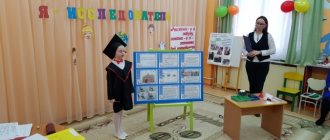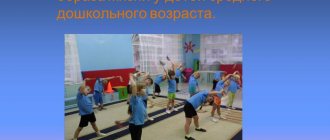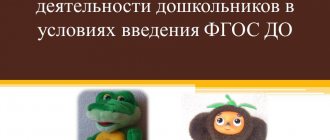Presentation “Entertaining mathematics” for children of senior preschool age
Explanatory note to the presentation on the development of mathematical concepts “Entertaining mathematics” for children of senior preschool age
Author: Vanyukova Svetlana Leonidovna,
teacher
MDOU "Finno-Ugric kindergarten"
combined type No. 20 “Lumichello”,
Petrozavodsk city
Target:
Forming children's interest in mathematics using multimedia technologies.
Tasks:
- improve counting skills within 10,
- develop the ability to solve logical problems,
- consolidate knowledge about temporary relationships,
- develop the ability to compare two groups of objects and establish relationships between objects: “more, less, equal”,
— train children in solving examples on addition and. subtraction within 10,
- develop logical thinking, visual perception, voluntary attention, fine motor skills.
The target audience:
children of senior preschool age 6-7 years old.
Materials and equipment:
laptop, presentation, interactive whiteboard, printouts with assignments.
Note:
Slide 2 has built-in hyperlinks (in the images of the balls) that redirect to the slides with the task. After discussing, the children choose which color ball they will press. Returning to the slide with heroes is done by clicking on the cloud image. The text of the characters’ assignments is read by the teacher (or you can make an audio recording and embed it in the presentation).
On slide 3, the answer appears by clicking on the images of the books.
On slide 4, to check whether the task was completed correctly, you need to click on each ball.
On slide 5, to change the task, click on the orange arrow in the lower right corner. Children answer by showing cards with the color of the clock. The answer is checked by clicking on the image of the clock (if you answer incorrectly, the image will disappear).
On slides 8 and 9, the answer appears by clicking on the task card.
Having completed all the tasks, the teacher sums up the lesson.
Tasks that require individual completion and develop the graphic skills of preschoolers should be printed out for each child (tasks from slides 8, 9).
“Entertaining mathematics” PPTX / 10.81 MB
Tasks included in the presentation:
Logical task “Find the book”
Target:
develop logical thinking and intelligence.
Logic problem “Balls”
Target:
teach children to divide the whole into parts and establish connections between them.
Task “Tell the time”
Target:
consolidate temporary relationships in children of older preschool age.
Task “Solve Examples”
Target:
strengthen the ability to solve examples on addition and subtraction.
Task “Place the right sign”
Target:
develop the ability to understand the relationships of adjacent numbers.
List of used Internet sources:
https://mishutkina-shkola.rf/98/75.jpg
https://media.istockphoto.com/photos/wall-clock-isolated-on-white-background-seven-oclock-picture-id1029298410?k=6&m=1029298410&s=612×612&w=0&h=XYmPt5TR2CN9-UIMyk9YSSz4ldUQjk0kPtTNu7Cla0I=
Presentation for parents “Playing math at home” presentation
Slide 1
“We play mathematics at home” Presentation for parents, teacher Klishina E. D. MBDOU “kindergarten No. 228 “Teremok” 9th group
Slide 2
Goal: to attract parents’ interest in entertaining material, to help them understand the significance of its use in a family setting. How to make math games interesting for your child: be sure to consider the age for which the task is intended. doesn’t want to - don’t insist, change tactics, offer a different type of game; especially with kids, use objects from life. For example, take vegetables and fruits for comparison, collect sticks of different lengths on the street and arrange them by length, from longest to shortest; don't focus on failures and don't do everything for him. the child himself must come to a logical conclusion; if something doesn’t work out, gently end the game and continue playing it after some time; Do not limit yourself to the word “Well done,” praise the child for his attempts and diligence, for his actions. But don’t overdo it, everything should be in moderation so that he wants to play not for the sake of praise, but for the sake of educational interest.
Slide 3
There are a huge number of types of mathematical games, so even a child who does not show interest in numbers and counting can find an activity that he will definitely enjoy. A walk is a great time to introduce your child to math in a fun and engaging way: “Let's take 10 big steps and 2 small ones?” “How about we do one jump and five steps?” “How many steps do you think it takes to get to that fire hydrant? Do I need to take more or fewer steps than you? How long?" “How many of your friends do you think we will meet today?” "Let's count the pigeons!" Games with construction kits and puzzles. Construction sets open up opportunities for the mental development of our children, namely their spatial thinking. These are: Wooden cubes. LEGO. Magnetic constructors. Tangram. Nikitin cubes.
Slide 4
The kitchen is a great place to learn math! When your children want to tinker in the kitchen, do not drive them out of there, but rather try to channel their energy in the right direction. “I need a medium bowl for this salad. Which one do you think is the right size?” “The recipe calls for three eggs. I put one. How much more do we need? “Can you measure out one cup of oatmeal for me?” “We need 1.5 cups of flour. I have 1 cup, how can I measure 1.5 cups using this cup?”
Slide 5
A walk is a great time to introduce your child to math in a fun and exciting way: - “Let's take 10 big steps and 2 small ones?” - “How about we do one jump and five steps?” - “How many steps do you think you need to take to get to that fire hydrant? Do I need to take more or fewer steps than you? How long?" - “How many of your friends do you think we will meet today?” " - "Let's count the pigeons!"
Slide 6
Incorporate math into your daily life. “I washed all my socks! Can you help me put them in pairs?” “Before we read the book, each of you must put 10 things back into place. One-two-three, let's go!” “Oh look! What a mess this drawer is! I need your help. Let’s put these things in the basket and sort them by color!”
Slide 7
Play math board games with the whole family.
Slide 10
Games for orientation in space (right and left)
Slide 11
Play is joy and pleasure for children. With its help, you can acquire new knowledge for later life.
Slide 12
Thank you for your attention!
Presentation “Preparing children for school in the middle group through FEMP”
Regina Dementieva
Presentation “Preparing children for school in the middle group through FEMP”
1 — «Preparing children for school in the middle group through FEMP».
Considering that gaming activity is the leading one for preschool children , I came to the conclusion that the maximum effect with FEMP can be achieved using didactic games, entertaining exercises, and tasks.
2- Teaching mathematics to preschool children is unthinkable without the use of entertaining games, tasks, and entertainment
• Currently, in connection with the improvement of the upbringing and education of children, a search is being made for new methods and means of teaching , and those that help identify the potential capabilities of each child.
3- Preschoolers have access to the simplest types of entertaining tasks. According to the developmental impact on children, the following main types can be distinguished:
• 1. Entertaining questions, tasks, jokes, promoting the development of logical thinking and intelligence, which are a method of activating mental activity.
4- 2. Problems – puzzles, the purpose of which is to create figures from the specified number of counting sticks:
3 equal squares of 10 sticks...
Problems on constructing simple figures
Problems for constructing complex figures
5-
3. Group of composing games
(modeling)
flat or three-dimensional images of objects.
Puzzle "Pythagoras"
,
"Tangram"
.
6- 4. Visual tasks are very diverse: from the simplest - on empty cells, continuation of a series, to more complex ones - finding patterns in rows of figures, signs of the difference between one group of figures and another .
7- In the process of solving these problems, children develop the ability to compare, generalize, prove, and draw conclusions
8- Developing elementary mathematical concepts children of a preschool institution , entertaining didactic material is used both in class and outside of them to organize independent activities.
9- The development of elementary mathematical concepts in children is not only knowledge of numbers, numbers, and problem solving, but also orientation in space, knowledge of geometric shapes, identification of three-dimensional and flat shapes.
10- We teach the child to distinguish and correctly name the basic geometric shapes (circle, square, triangle, rectangle, compare and distinguish objects by size and color.
11- We learn to determine the position of objects on a plane, know words denoting location and correctly understand their meanings: in front, behind, right, left, above, above, under, behind, in front.
In order for schooling to be successful , we (educators)
there are other tasks...
12- Developing fine motor skills of the child’s hand. This helps us with drawing, shading, coloring, stringing beads, buttons, modeling, blindly determining the shape of objects (first the simplest ones, then you can make them more complicated, playing with small objects (mosaics)
.
13- Using lotto and books, we teach children the names of: wild and domestic animals, birds, wild and garden flowers, trees, dishes, pieces of furniture, clothing, hats, types of shoes, toys, school supplies, body parts , names of cities , names of favorite fairy tales and their heroes.
14- Developing children's . We learn to retell fairy tales and cartoon content. We make up stories based on pictures. We monitor the child’s correct pronunciation and diction. We speak tongue twisters.
15- As a result of training, the child should learn to: think, reason, give answers meaningfully, logically justifying them - which means we have achieved the desired result.








